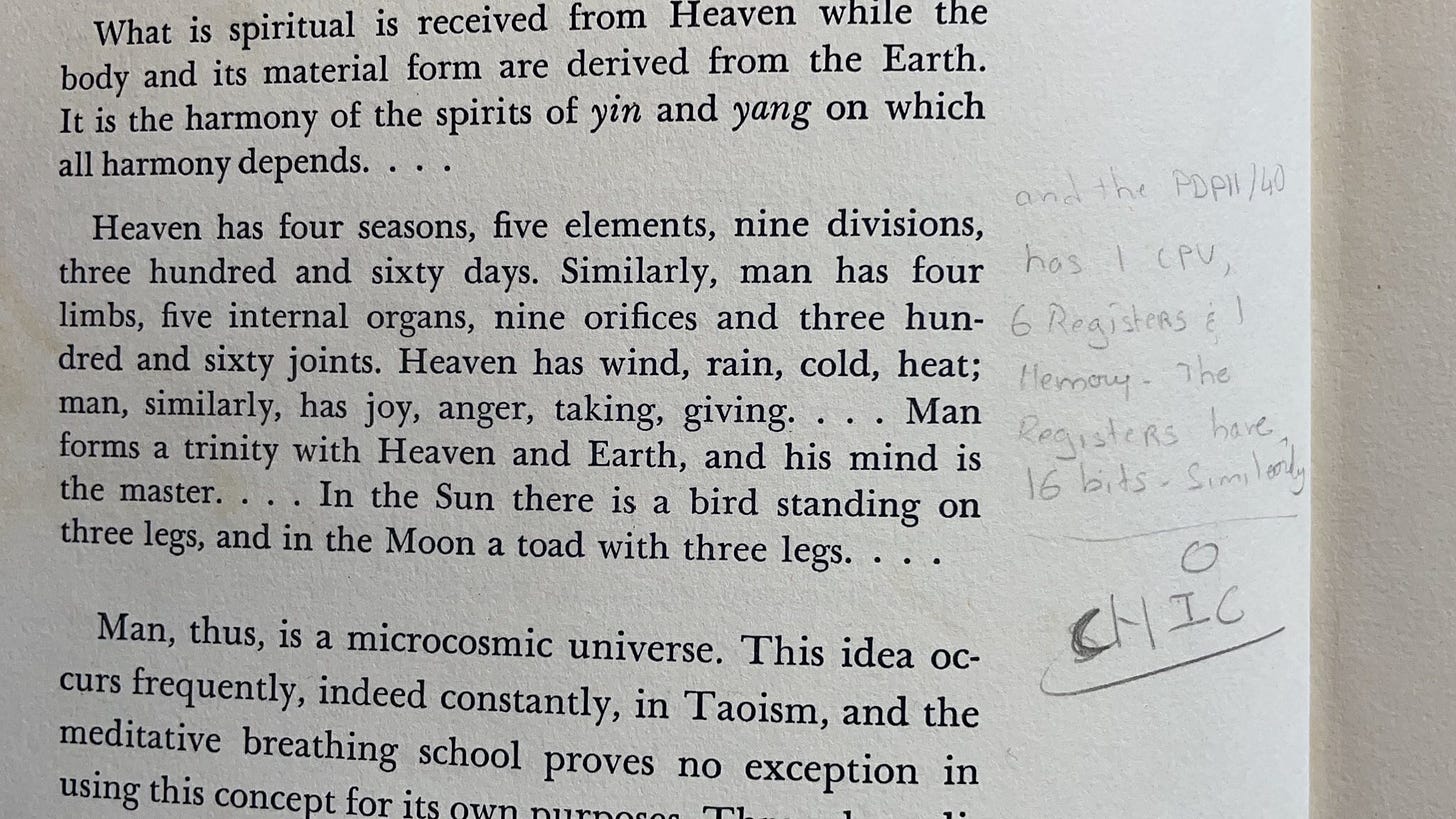Hacking the Huainanzi
A 50-year-old handwritten note weaves ancient Chinese numerology into a 1970s minicomputer
This morning, while waiting for my daily hard-boiled egg to finish its process, I sought inspiration for the day by leafing through the pages of a book titled Creativity and Taoism. I wasn’t the first to do so. Originally published in 1963, written by the philosophy professor Chang Chung-yuan, the book, which I retrieved from the stacks of UC Berkeley’s Main Library, has a well-thumbed feel.
My eyes were glazing over at one numerologically dense quotation from the second century text, the Huainanzi -- “Heaven has four seasons, five elements, nine divisions, three hundred and sixty days. Similarly, man has four limbs, five internal organs, nine orifices and three hundred and sixty joints” – when a handwritten note in the margin caught my notice.
And the PDP 11/40 has 1 CPU, 6 Registers & 1 Memory – The Registers have 16 bits -- Similarly
CH IC
I’m a sucker for bizarre juxtapositions, but this one caught me short. The Huainanzi is a second century BC text that I referenced in Book Knife Swag for its self-conscious “writing-as-weaving” structure. The PDP-11 was a minicomputer made by DEC popular in the mid-1970s and considered an important evolutionary step between the hulking mainframes of computing’s first age and the era of personal computers. You cannot tell the story of the creation of the Unix operating system or the C programming language without referencing the PDP-11.
I know this because it just so happens that at one point in my career as a technology journalist, I wrote a very deep dive about a group of computer programmers at UC Berkeley, who, while working with the PDP-11 in the mid-70s, laid the substrate down for the free and open source software movement: BSD-Unix: Power to the people, from the code.
So many questions! Was this anonymous commenter, curious about the Dao and computer literate beyond 99 percent of Berkeley students or faculty at the time, a member of that group of programmers? Had I interviewed them? What possible connection did this person mean to suggest between the PDP-11’s architecture and ancient Chinese philosophy? What did the abbreviation CH IC stand for? Could it be Chinese integrated circuit?
And was there anyone on the planet who would be driven more mad by this puzzle than yours truly? It does not always work like this but this morning, when I went seeking inspiration from the Dao… I FOUND IT.
I emailed Eric Allman, the author of the pioneering email application Sendmail, and a computer science student at Berkeley in the ‘70s.
Yes, he told me, “there was a PDP-11/40 that lived on the 4th floor of Evans Hall. It was shared by math, statistics, and computer science.” And yes, Bill Joy, the programming wunderkind who led the development of BSD and went on to co-found Sun Microsystems, had “probably” used that machine, but had done “most of his effort” on a dedicated, and more powerful, PDP-11/70.
Did he recall whether any of his fellow hackers might have been interested in Daoism?
“Probably a bunch of people, but no one who pops into my head.”
Probably a bunch of people! Ah, well, this is likely where the well runs dry. And maybe that’s for the best. The truth is that my eyes tend to glaze over whenever I encounter ancient Chinese numerological fixations. The forced parallel between the text of the Huainanzi and the technical specifications of the PDP-11/40 also reeked just a little bit too much of sui generis Berkeley indulgence.
I am seized by a vision; I see a person sitting on the porch of a back-yard bungalow in North Berkeley in 1973, taking a big hit off of a joint while Creativity and Taoism lies open on their lap. I see the wheels turning in their head, the synaptic connections firing, the awesome unity of the digital with the Dao coalescing.
But this is not creativity; this is stoner bullshit.
Then again, the connections between drug-induced enlightenment and the evolution of the personal computer are well-documented. And there can be no doubt that the PDP-11 was a crucial link in the emergence of the marvelous creativity-empowering tools we enjoy today, the very tools that I am using to write and distribute this post.
Those 1970s Berkeley programmers were smack in the middle of it, weaving ones and zeroes into the ubiquitous infrastructure of modernity. What right do I have to scoff at the awesome arcanity of ancient numerology, or the mysterious intersection of second century mysticism with mid-70s minicomputer advances when my daily existence is entirely dedicated to using technology to chase enlightenment?
Maybe after finishing that joint, my Daoism-curious correspondent from the past went back to the computer lab and hacked a new reality into being.
Or maybe they read the next couple of paragraphs in the Huainanzi quotation and decided to call it a day.
Heaven has wind, rain, cold, heat; man, similarly, has joy, anger, taking, giving…. Man forms a trinity with Heaven and Earth and his mind is the master… In the Sun there is a bird standing on three legs, and in the Moon a toad with three legs.
Cue the author’s analysis:
Man, thus, is a microcosmic universe.
Seems about right.



Well, weird. Which doesn’t make it wrong.